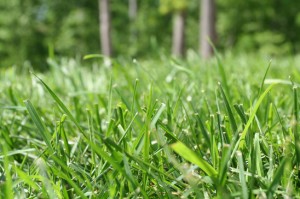5 Different Types of Grass
The best Canadian lawns are made up of a mix of different types of grass species. Lawns that have several different kinds of grass can tolerate a wider range of growing conditions and are usually less vulnerable to pest damage than lawns that only have one type of grass. Grass is either cool-season or warm-season with specific requirements for thriving.
 Kentucky bluegrass
Kentucky bluegrass
Kentucky bluegrass (Poa pratensis) is the main grass in most lawn mixtures, and there are several good reasons for this. It is a cool-season grass and has the deep blue-green colour that is so popular. It is cold-hardy as well as heat-hardy, which means it is dependable for many climates. It likes full sunlight, but a little shade is all right. It should be watered frequently and needs well-drained soil because it has a shallow root system. Kentucky bluegrass can be fertilized regularly and flourishes in the fall and spring.
It can be easily grown from seed and gives a highly dense attractive lawn. It is used for showcase places such as golf courses, cemeteries, parks as well as private homes.
Ryegrass
Ryegrass (Lolium perenne) is a cool-season grass that is better for cooler climates such as Toronto. It can sustain itself during winter and extended dry spells. It is a very strong type of grass and is used for sports fields, private homes, hotels, playgrounds and other places where there is a lot of foot traffic on the lawn. It should be fertilized about three to five times a year and watered regularly, but it can go without water for a while.
Tall Fescue
Tall Fescue (Festuca arundinacea) is a cool-season grass that grows well in sun or shade. It is very low maintenance so is popular for commercial grounds, playing fields as well as private homes. It is compatible with other types of grass and has a deep root system, which is why it can tolerate times of drought and heat. It is the most heat tolerant of all the cool-season grasses. This is why it is the grass of choice for public areas and playing fields where there may not be much irrigation. It takes up to two weeks to sprout so it is slow to become established as a lawn. It should only be fertilized two to four times a year.
Bermuda grass
Bermuda grass (Cynodon dactylon) is a warm-season grass that likes hot weather and needs a lot of water to stay green. It provides a very short lawn, but needs lots of sunlight. This is a good grass for putting green because it can be mowed to ½ to 1/8th inch. Bermuda grass can be mixed with perennial ryegrass to keep a good looking lawn during the summer heat. The ryegrass will die off in the late spring and the Bermuda grass will take over. This will happen again in the fall.
Canada blue grass
Canada blue grass (Poa compressa) is a very hardy cool-season grass that is planted in the northern United States and Canada. It is a fine-textured grass and is a creeper. It is very low maintenance, so it is planted in conservation areas such as on the banks of streams and in places that are difficult to access for upkeep. It will grow in very poor, rocky or sandy soil and likes full or partial sunlight.
Bags of grass seed from the store probably have a little of each of these types of grasses. This is to ensure that something works and the purchaser gets a lawn. It may not look uniform, but it will be green. However, it is possible to have a gorgeous lawn with a little care about the purpose of the lawn, cool or warm-season grasses, soil type, sunlight or shade and drainage. Whichever type of lawn it is, it will prevent soil erosion, buffer temperatures, absorb water and filter pollution.

Leave a Reply